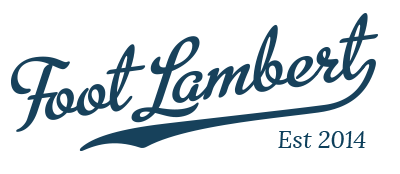BARC National Championship at Cadwell Park
The 8th and 9th of September saw the Cadwell Park rounds of the BARC National Championship. This collection of races includes the UK Legends championship, MG owners club, two Caterham championships, Group 1 touring cars among others. I went over on the Saturday to photograph the action, and this was my second trip to Cadwell Park. I previously went to the VSCC Shuttleworth and Nuffield Trophies at the start of the summer.
I think that Cadwell Park is one of the most photogenic circuits in the UK, with it’s lush green landscape, thick forest sections and a thin ribbon of tarmac cutting through the countryside. This time I took with me two cameras; my old faithful and work donkey Canon 5D (with 28-135mm IS, and 70-200mm IS II with 1.4 extender), and a recently acquired Mamiya C330F medium format TLR, with a 80mm lens Sekor ‘blue dot’ lens. I chose to use Kodak Ektar 100 and Ilford FP4 roll film to photograph cars in the paddock.
Using depth of field static shots
One type of shot that I have always shied away from is the depth of field still shot, which is commonly used in magazine articles covering motorsport photography. These use a large aperture, and shallow depth of field to give a sense of depth to a photograph, rather than using slow shutter speed panning techniques to capture the action. I’ve never really liked this style of shot, because to me they fail to convey the drama and excitement of motorsport.
On this occasion however, I forced myself to try it out. Using the 70-200mm lens with a 1.4 extender, I photographed cars entering the Hall Bends section of the circuit. This would allow me to frame a car entering the corner, with competitors being blurred in the background.
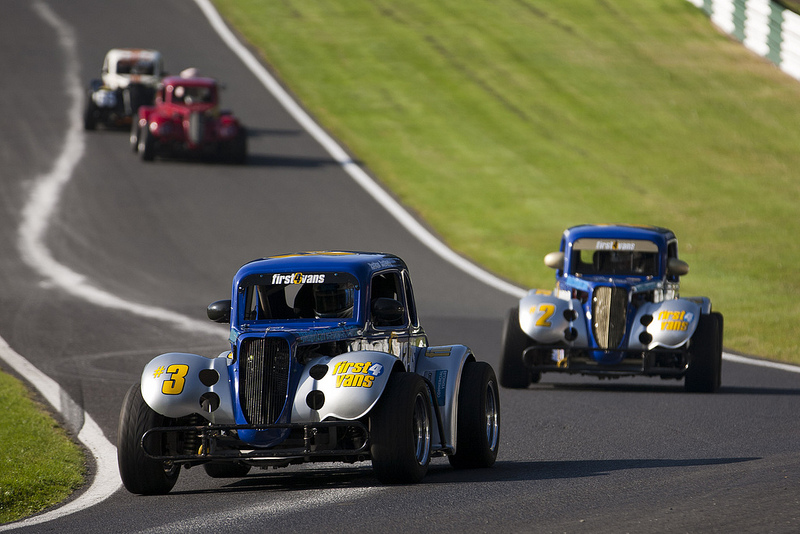
I used these team mates to create a photograph with narrative. f/4.0 allowed the following cars to become progressively more blurred. For this style of shot, image construction is the real key to generating a decent photograph.
I found with these shots, pre focusing on a section of the track, and allowing the car to come to me was the best way to photograph these subjects. Here, the white lines of the track lead the eye to other cars, and I found that only certain sections of the circuit would lend themselves to this type of shot. As spectator areas are usually not in the direct line of cars entering corners, a media pass would be a much greater benefit for getting a decent position to create this type of photograph.
It’s all in the framing
There is a very dramatic section of track at Cadwell Park, known as ‘The Mountain’. Here the track rises steeply, and I wanted to use the depth of field style of image to construct a photograph.
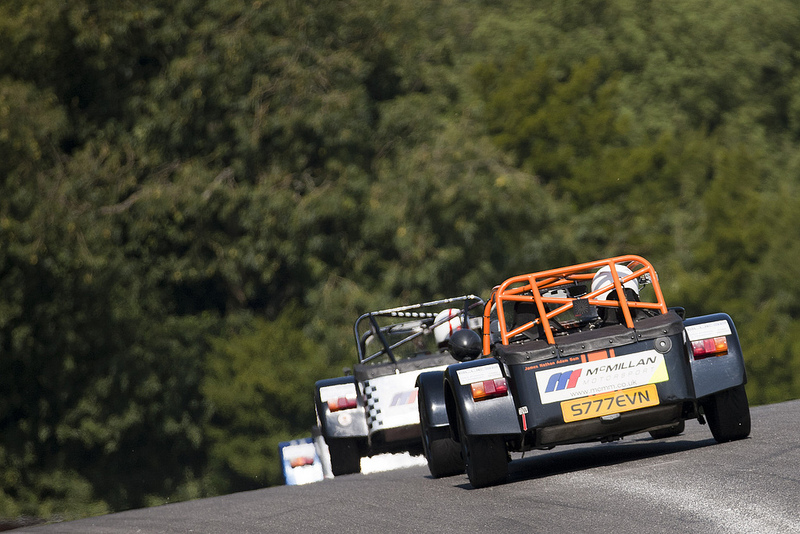
Leaning and framing a shot as cars go over the mountain created an image of contrasts; sharp cars, against the out of focus trees in the distance. Triplication of similar shapes draws the eye through the photograph.
I was surprised to find that this style of photograph required as much trial and error as panning. The narrow depth of field means that cars will be in focus for a very short amount of time, and constant firing was needed to capture a decent shot.
Wide is the way to go
Throughout my day at Cadwell Park, I found myself using my 28-135mm lens much more than the 70-200mm. I believe it’s sometimes a common misconception that long lenses are the only way to photograph sport. Although this can be true for some shots, I feel that wide angles can give a better sense of scale and drama. Capturing cars fighting with eachother can be easier when side on to the track when using a wide lens, compared to a long one.
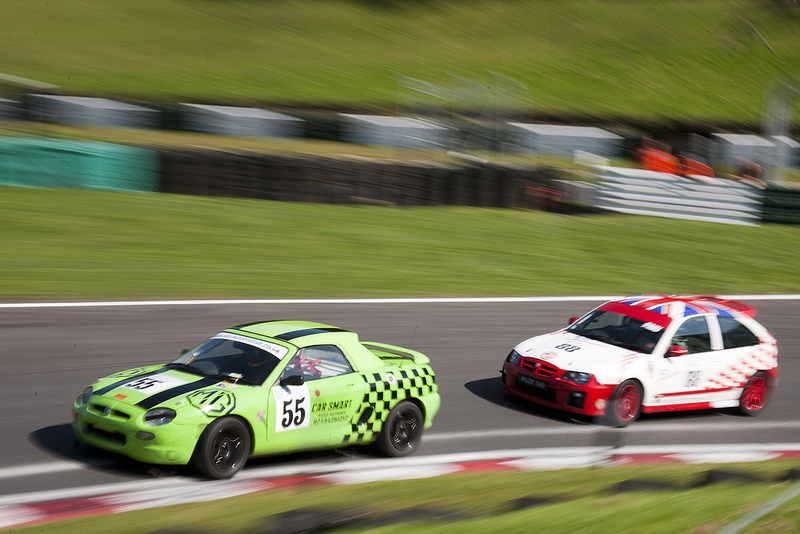
A wide lens and a slow shutter speed gave a great impression of speed, as these two cars battled for the lead of the race. The photograph feels dramatic and alive, with vibrant colours and blurred background shapes.
I’d certainly like to try an even wider lens, such as the 16-35mm, as I feel that this could create some really interesting effects. However, these photograph only really work best then you are really close to the action, otherwise cars can feel lost in the frame.
Exit frame left
Another basic rule of photographing action is to have lots of space in front of the subject for it to move into. This is another classic technique I wanted to reverse, by having a subject be at the edge of the frame but to still work as a photograph. I felt that this needed to have an additional element in the frame, and the top of the Cadwell circuit was the ideal place to try this out.
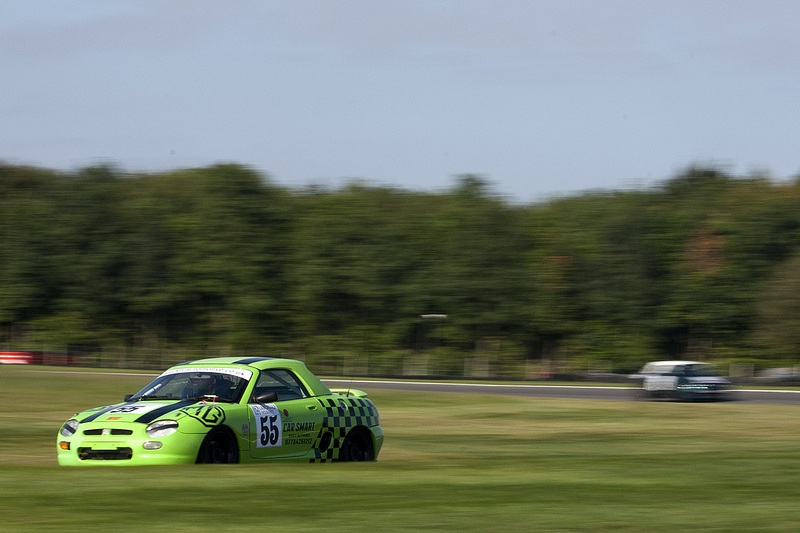
One subject is exciting the frame, but the suggestion of another in the background adds to the narrative. I used simple rules of thirds and grids to construct this image.
I felt that this style of shot had an implied narrative, and would be good to use in race situations. A slightly faster shutter speed may have given the subject in the background better definition, but might not have been as subtle.
A scary incident, a lucky escape
While photographing at Cadwell, I experienced my first ‘big crash’. I’ve seen cars have accidents at circuits before, but nothing quite so spectacular. The #74 car of Robert King and #41 car of Elliot Bunn made contact going into the Mountain section of the circuit. The first thing I heard was a loud smash, before turning and seeing the #74 flip onto it’s side. Here, I just pointed my camera roughly in the direction of the crashing sounds, and held down the shutter button.
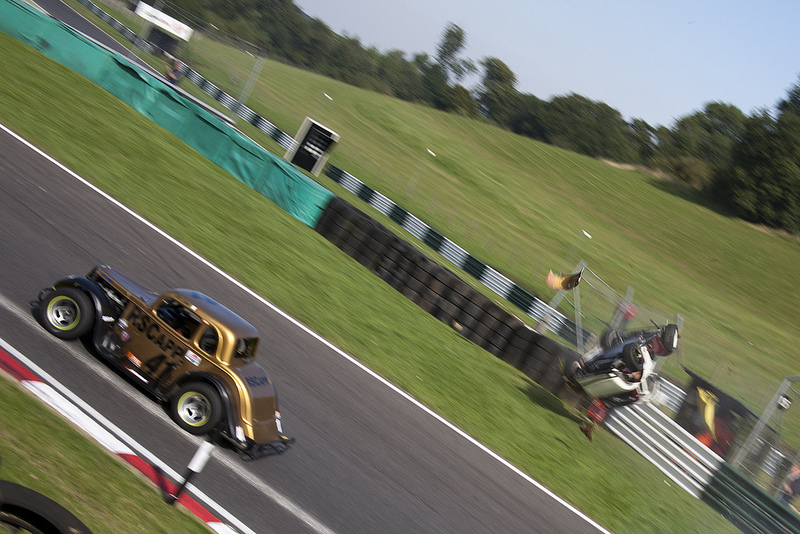
A scary moment at Cadwell, with Robert King rolling his Legends car. Firing madly, and with little time to focus properly, this blurry shot still manages to capture the drama.
I felt quite shaken after seeing such a dramatic crash, so I can only imaging how Robert King felt strapped inside the car. The marshals and rescue crew were on the scene within seconds, and he was helped out of the car. For me, it did raise the question of weather you keep photographing the incident after the car has come to a rest – is it right to do so? On one hand, it’s quite morbid until you know the driver is OK, but on the other, having a record of what happens is part of a photographers duty. Thankfully, Robert was OK after being checked out at the medical centre.
Using 6×6 in the paddock
After being inspired by the Dennis Boussard Le Mans book I decided to try some 6×6 shots on the Mamiya in the paddock. After using a Rolleicord at Cadwell park’s VSCC event and at the Mallory Park VSCC event, I was expecting good things from the Mamiya. I used Ilford FP4 (processed in DD-X) to photograph parts of the cars and people in the pitlane working on them.
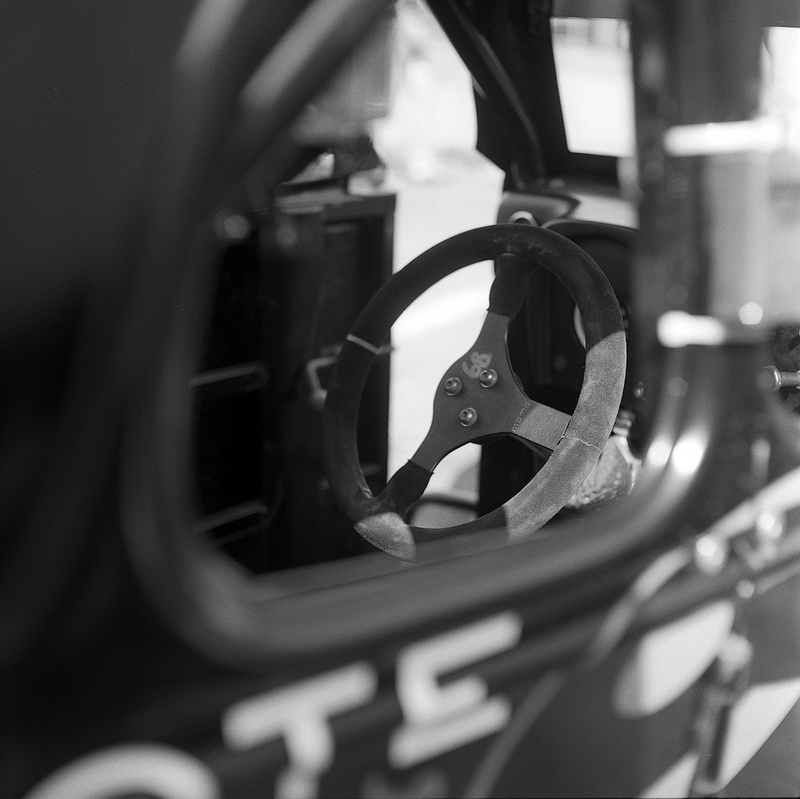
Excellent detail from the 80mm lens even captures the fine texture of the Legends car steering wheel. I shot through the window with a large aperture to create a sense of depth. Details like the car number on the wheel added extra interest.
I was amazed with the level of detail that the 80mm Mamiya Sekor lens picked up, and how good the Bokeh was. The Ilford FP4 gave really fine results too, with very little grain. The bright conditions made it a challenge to use, as there were high contrasting highlights and shadows. Colour film was also used in the paddock, and with such interesting paint schemes on the cars proved to be a good subject to try out.
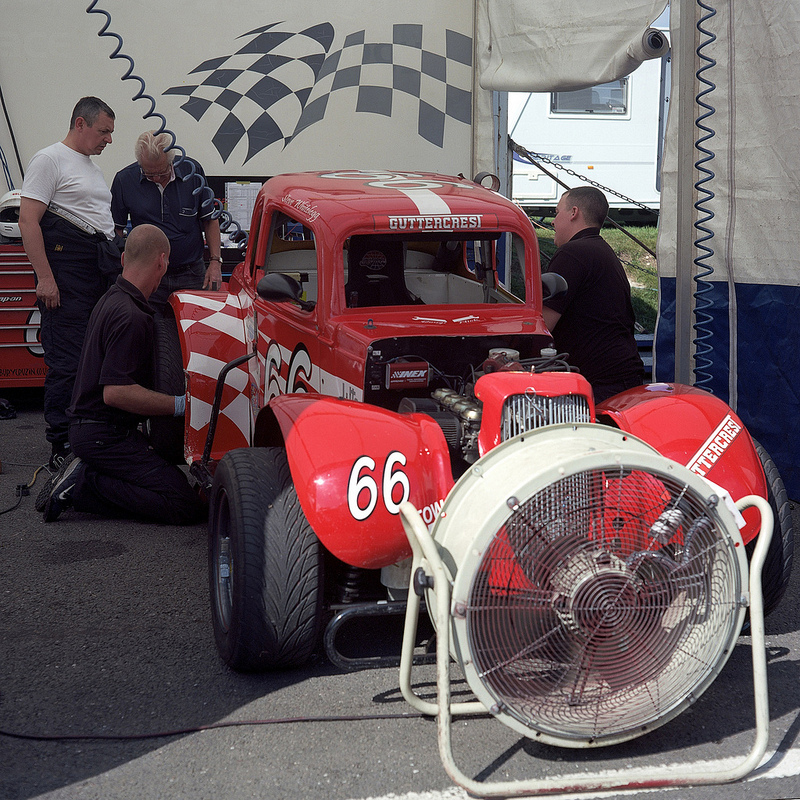
The image quality of this camera is exceptional, but I feel as though my ability to frame and chose the appropriate apertures for effect still needs a lot of work.
Colours from the Ektar film as striking as I’ve come to expect. The image quality generated by the Mamiya is certainly very high, but I felt that few of my shots really used it to an advantage. I need to pick apertures that are more effective, and frame better detail shots. The bright conditions did make this tough, as the lens shutter speed only goes as high as 1/500. I need to become more familiar with what works on 6×6, and how to make best use of the unique quality of the frame.
Summing up and further reading
I learnt a lot of new techniques from this trip to Cadwell Park. Depth of field shots were certainly a new way of thinking compared to panning, and reacting to the big accident was also something that I’d not had to do before. I really feel that wide lenses are very good for capturing a sense of scale at tracks with decent landscapes and scenery. As for using the Mamiya, this has been the biggest challenge. I know the image quality of the camera is faultless, but my ability to frame and construct decent photographs with it will need a lot of practice. I think this will become my project camera for the foreseeable future.
You can find out more about the BARC championships on their website. Cadwell Park also has a website, and I would strongly recommend a trip to see some two or four wheeled action. You can see the rest of my photograph in my BARC National Championship at Cadwell Park Flickr Set, and if you have any questions please feel free to either contact me, or fill in the comment form on this page.
Posted in: 6x6, BARC, Digital, Medium Format, Motorsport
